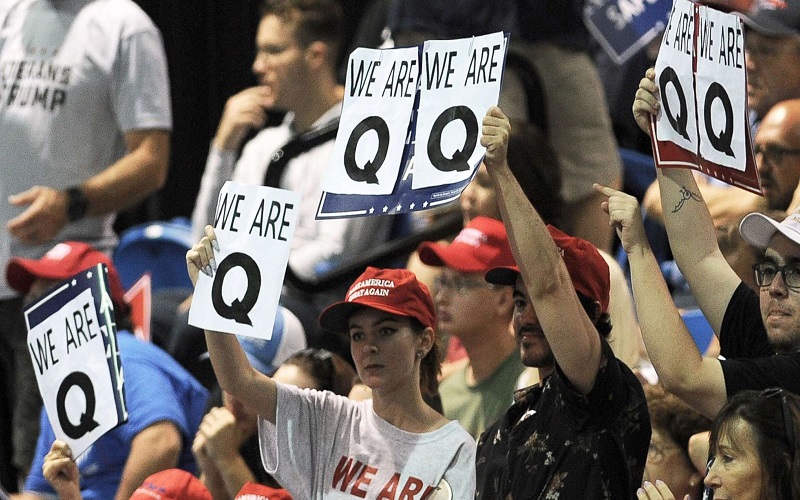
Photo credit: ABC News


November 24, 2020
By Vegas Tenold, Investigative Researcher, ADL Center on Extremism
President Trump’s loss to President-elect Joe Biden in the 2020 U.S. presidential election has presented the QAnon movement with a conundrum -- and a test of its ability to survive in the face of total cognitive dissonance.
For many QAnon believers, who subscribed to a movement founded on the notion of President Trump’s utter infallibility, the idea of an electoral loss was simply unthinkable. If anything, in 2020, Trump was going to enjoy an even greater electoral win than he did in 2016. In fact, so sure were QAnon believers of President Trump’s coming election success, that even before the election took place, hashtags like #redwave, #redtsunami and #all50states were trending on Parler, a social media platform popular among QAnon followers and right-wing extremists. When President Trump lost the election, QAnon supporters were left flailing, searching for answers.
Throughout the 2020 presidential campaign, any misstep or gaffe by President Trump was dismissed by QAnon as part of the Plan, which is what QAnon supporters call the scheme that Q and Trump were ostensibly enacting to expose the nefarious Deep State. Any polls showing a Democratic advantage were considered “Deep State disinformation.”
The morning of November 3, 2020, Joe M, one of the most popular QAnon influencers, wrote on Parler, “Election night is when I watch only CNN or MSNBC. The agony will be priceless.” That same morning, Q posted a picture of the American flag together with an Abraham Lincoln quote and the caption, “Together we win.”
According to election results, of course, Trump did not win in a landslide and there was no red tsunami. Presumably due to this, Q stopped posting for nine long days. During the most critical time of the conspiracy theory’s three-year history, Q’s followers were forced to fend for themselves. To make matters worse, on November 3, 2020, Ron Watkins, the administrator of Q’s online home 8kun, announced that he planned to leave his position. (Ron Watkins is the son of Jim Watkins, who is 8kun’s owner, and as some have speculated, the real Q). QAnon adherents wondered: Could this mean that Q would retire too? Trump’s loss, the disruption of Q’s network and Q’s radio silence presented a profound test of faith for believers.
It was a time of despair for some of Q’s followers, but as QAnon is not a movement deterred by reality, the host of influencers who make up the QAnon high priesthood quickly leapt into action with a handful of explanations for President Trump’s electoral loss.
QAnon die-hards, along with much of the MAGA world, believed that the election had been stolen from Trump via widespread voter fraud. QAnon followers pushed wild ideas, like the debunked Sharpiegate-theory, which claimed that voters in Arizona had used pens that could not be read by vote counting machines. Some QAnon believers blamed the voting machines themselves, claiming without evidence that Dominion Voting Systems, a company that sells voting equipment, had deleted millions of votes. This theory eventually made its way to President Trump who tweeted it out in all-caps.
On November 5, 2020, two armed men driving a vehicle adorned with Q stickers were arrested near the Convention Center in Philadelphia where vote-counting was underway, as Pennsylvania’s counting efforts were the target of intense and unfounded accusations of fraud. QAnon believers were also a prominent part of the many Stop the Steal rallies that took part around the county.
This is where the conundrum surfaces: QAnon believers’ narrative of fraud fits neatly with President Trump’s own version of events but does not square with QAnon’s overarching belief that the president is infallible. If President Trump was a victim of fraud, then clearly the Plan was flawed for failing to account for this possibility. For true believers, this notion was absurd on its face: The Plan could never fail. That was the whole point of QAnon. At this moment, almost as if sensing this cognitive dissonance, Q stepped in. On November 12, 2020, in his first post in nine days, Q dropped a rambling list of acronyms and links and implied that the “fraud” had been part of The Plan from the very beginning, devised to show the American people the crimes of the Deep State. “How do you 'show' the public the truth?” Q wrote. “How do you 'safeguard' US elections post-POTUS? How do you 'remove' foreign interference and corruption and install US-owned voter ID law(s) and other safeguards? It had to be this way. Sometimes you must walk through the darkness before you see the light.”
The message to the faithful was that everything was going according to The Plan. President Trump was playing four-dimensional chess the way he always did.
So far there is no indication that Trump’s electoral loss has put a damper on the enthusiasm of QAnon followers. In fact, it seems to have had quite the opposite effect. In the face of what QAnoners fear the most—a Democrat in the White House—the conspiracy theory provides what its believers need: a sense of control.
At its core, QAnon is selling the idea that everything happens for a reason and that the pieces are falling into place. All the believers need is faith. According to psychologists, conspiracy theories provide a way to make sense of an often-senseless world. Part of the reason for QAnon’s success is its ability to explain the world in a way that makes some kind of sense to the faithful. To QAnon believers, President Trump’s failure to deliver on his promises can be blamed on the Deep State, the global pandemic is a hoax perpetrated by Trump’s enemies and Trump can never lose unless his opponents break the rules.